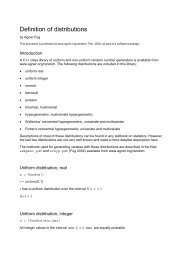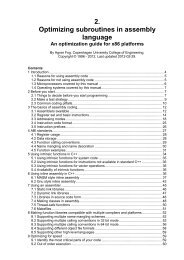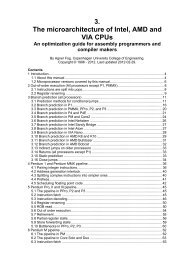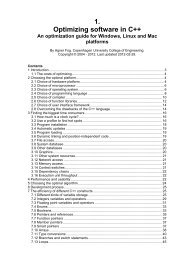4 Instruction tables - Agner Fog
4 Instruction tables - Agner Fog
4 Instruction tables - Agner Fog
You also want an ePaper? Increase the reach of your titles
YUMPU automatically turns print PDFs into web optimized ePapers that Google loves.
Sandy Bridge<br />
Intel Sandy Bridge<br />
List of instruction timings and μop breakdown<br />
Explanation of column headings:<br />
Operands:<br />
i = immediate data, r = register, mm = 64 bit mmx register, x = 128 bit xmm register,<br />
(x)mm = mmx or xmm register, y = 256 bit ymm register, same = same<br />
register for both operands. m = memory operand, m32 = 32-bit memory operand,<br />
etc.<br />
μops fused domain:<br />
μops unfused domain:<br />
p015: The total number of μops going to port 0, 1 and 5.<br />
p0: The number of μops going to port 0 (execution units).<br />
p1: The number of μops going to port 1 (execution units).<br />
p5: The number of μops going to port 5 (execution units).<br />
p23: The number of μops going to port 2 or 3 (memory read or address calculation).<br />
p4: The number of μops going to port 4 (memory write data).<br />
Latency:<br />
This is the delay that the instruction generates in a dependency chain. The<br />
numbers are minimum values. Cache misses, misalignment, and exceptions<br />
may increase the clock counts considerably. Where hyperthreading is enabled,<br />
the use of the same execution units in the other thread leads to inferior performance.<br />
Denormal numbers, NAN's and infinity do not increase the latency.<br />
The time unit used is core clock cycles, not the reference clock cycles given by<br />
the time stamp counter.<br />
Reciprocal throughput:<br />
Move instructions<br />
The number of μops at the decode, rename, allocate and retirement stages in<br />
the pipeline. Fused μops count as one.<br />
The number of μops for each execution port. Fused μops count as two. Fused<br />
macro-ops count as one. The instruction has μop fusion if the sum of the numbers<br />
listed under p015 + p23 + p4 exceeds the number listed under μops fused<br />
domain. A number indicated as 1+ under a read or write port means a 256-bit<br />
read or write operation using two clock cycles for handling 128 bits each cycle.<br />
The port cannot receive another read or write µop in the second clock cycle, but<br />
a read port can receive an address-calculation µop in the second clock cycle.<br />
An x under p0, p1 or p5 means that at least one of the μops listed under p015<br />
can optionally go to this port. For example, a 1 under p015 and an x under p0<br />
and p5 means one μop which can go to either port 0 or port 5, whichever is vacant<br />
first. A value listed under p015 but nothing under p0, p1 and p5 means that<br />
it is not known which of the three ports these μops go to.<br />
The average number of core clock cycles per instruction for a series of independent<br />
instructions of the same kind in the same thread.<br />
The latencies and throughputs listed below for addition and multiplication using<br />
full size YMM registers are obtained only after a warm-up period of a thousand<br />
instructions or more. The latencies may be one or two clock cycles longer and<br />
the reciprocal throughputs double the values for shorter sequences of code.<br />
There is no warm-up effect when vectors are 128 bits wide or less.<br />
Integer instructions<br />
<strong>Instruction</strong> Operands μops μops unfused domain Latency ReciCom- fused p015 p0 p1 p5 p23 p4<br />
doprocalthroughmentsmainput<br />
Page 119






